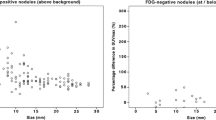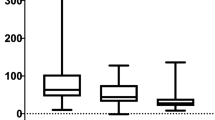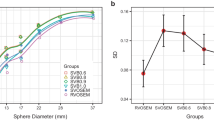Abstract
Objective
To determine whether the recently introduced Bayesian penalized likelihood PET reconstruction (Q.Clear) increases the visual conspicuity and SUVmax of small pulmonary nodules near the PET resolution limit, relative to ordered subset expectation maximization (OS-EM).
Methods
In this institutional review board-approved and HIPAA-compliant study, 29 FDG PET/CT scans performed on a five-ring GE Discovery IQ were retrospectively selected for pulmonary nodules described in the radiologist’s report as “too small to characterize”, or small lung nodules in patients at high risk for lung cancer. Thirty-two pulmonary nodules were assessed, with mean CT diameter of 8 mm (range 2–18). PET images were reconstructed with OS-EM and Q.Clear with noise penalty strength β values of 150, 250, and 350. Lesion visual conspicuity was scored by three readers on a 3-point scale, and lesion SUVmax and background liver and blood pool SUVmean and SUVstdev were recorded. Comparison was made by linear mixed model with modified Bonferroni post hoc testing; significance cutoff was p < 0.05.
Results
Q.Clear improved lesion visual conspicuity compared to OS-EM at β = 150 (p < 0.01), but not 250 or 350. Lesion SUVmax was increased compared to OS-EM at β = 150 and 250 (p < 0.01), but not 350.
Conclusion
In a cohort of small pulmonary nodules with size near an 8 mm PET full-width half maximum, Q.Clear significantly increased lesion visual conspicuity and SUVmax compared to our standard non- time-of-flight OS-EM reconstruction, but only with low noise penalization. Q.Clear with β = 150 may be advantageous when evaluation of small pulmonary nodules is of primary concern.




Similar content being viewed by others
References
Garcia-Velloso MJ, Bastarrika G, de-Torres JP, Lozano MD, Sanchez-Salcedo P, Sancho L, et al. Assessment of indeterminate pulmonary nodules detected in lung cancer screening: diagnostic accuracy of FDG PET/CT. Lung Cancer. 2016;97:81–6.
Verhagen AF, Bootsma GP, Tjan-Heijnen VC, van der Wilt GJ, Cox AL, Brouwer MH, et al. FDG-PET in staging lung cancer: how does it change the algorithm? Lung Cancer. 2004;44:175–81.
Grootjans W, de Geus-Oei LF, Meeuwis AP, van der Vos CS, Gotthardt M, Oyen WJ, et al. Amplitude-based optimal respiratory gating in positron emission tomography in patients with primary lung cancer. Eur Radiol. 2014;24:3242–50.
Vriens D, Visser EP, de Geus-Oei LF, Oyen WJ. Methodological considerations in quantification of oncological FDG PET studies. Eur J Nucl Med Mol Imaging. 2010;37:1408–25.
Asma E, Ahn S, Ross S, Chen A, Manjeshwar R. Accurate and consistent lesion quantitation with clinically acceptable penalized likelihood images. IEEE Nuclear Science Symposium Conference Record 2012.
Moyer VA, Force USPST. Screening for lung cancer: U.S. Preventive services task force recommendation statement. Ann Intern Med. 2014;160:330–8.
Fletcher JW, Djulbegovic B, Soares HP, Siegel BA, Lowe VJ, Lyman GH, et al. Recommendations on the use of 18F-FDG PET in oncology. J Nucl Med. 2008;49:480–508.
Cherry SR, Sorenson JA, Phelps ME. Physics in nuclear medicine. 4th ed. Philadelphia: Elsevier/Saunders; 2012.
Kinahan PE, Fletcher JW. Positron emission tomography-computed tomography standardized uptake values in clinical practice and assessing response to therapy. Semin Ultrasound CT MR. 2010;31:496–505.
Hudson HM, Larkin RS. Accelerated image reconstruction using ordered subsets of projection data. IEEE Trans Med Imaging. 1994;13:601–9.
Ahn S, Ross SG, Asma E, Miao J, Jin X, Cheng L, et al. Quantitative comparison of OSEM and penalized likelihood image reconstruction using relative difference penalties for clinical PET. Phys Med Biol. 2015;60:5733–51.
Teoh EJ, McGowan DR, Macpherson RE, Bradley KM, Gleeson FV. Phantom and clinical evaluation of the Bayesian penalized likelihood reconstruction algorithm Q.Clear on an LYSO PET/CT system. J Nucl Med. 2015;56:1447–52.
Teoh EJ, McGowan DR, Bradley KM, Belcher E, Black E, Gleeson FV. Novel penalised likelihood reconstruction of PET in the assessment of histologically verified small pulmonary nodules. Eur Radiol. 2016;26:576–84.
Teoh EJ, McGowan DR, Bradley KM, Belcher E, Black E, Moore A, et al. 18F-FDG PET/CT assessment of histopathologically confirmed mediastinal lymph nodes in non-small cell lung cancer using a penalised likelihood reconstruction. Eur Radiol 2016;26:4098–4106
MacMahon H, Austin JH, Gamsu G, Herold CJ, Jett JR, Naidich DP, et al. Guidelines for management of small pulmonary nodules detected on CT scans: a statement from the Fleischner Society. Radiology. 2005;237:395–400.
Gore RM, Thakrar KH, Wenzke DR, Newmark GM, Mehta UK, Berlin JW. That liver lesion on MDCT in the oncology patient: is it important? Cancer Imaging. 2012;12:373–84.
Parvizi N, Franklin JM, McGowan DR, Teoh EJ, Bradley KM, Gleeson FV. Does a novel penalized likelihood reconstruction of 18F-FDG PET-CT improve signal-to-background in colorectal liver metastases? Eur J Radiol. 2015;84:1873–8.
Acknowledgements
The authors would like to thank Priti Patel, CNMT for her assistance with the PET reconstructions and Steve Ross, PhD of GE Healthcare for his invaluable comments and suggestions regarding this work.
Author information
Authors and Affiliations
Corresponding author
Ethics declarations
Conflict of interest
Brandon Howard, MD, PhD, Rustain Morgan, MD, Matthew Thorpe, MD, Timothy Turkington, MD, Jorge Oldan, MD and Olga James, MD—no conflict of interest to disclose. Salvador Borges-Neto, MD—research grant from GE Healthcare, which did not fund any portion of the research described in this manuscript.
Rights and permissions
About this article
Cite this article
Howard, B.A., Morgan, R., Thorpe, M.P. et al. Comparison of Bayesian penalized likelihood reconstruction versus OS-EM for characterization of small pulmonary nodules in oncologic PET/CT. Ann Nucl Med 31, 623–628 (2017). https://doi.org/10.1007/s12149-017-1192-1
Received:
Accepted:
Published:
Issue Date:
DOI: https://doi.org/10.1007/s12149-017-1192-1




